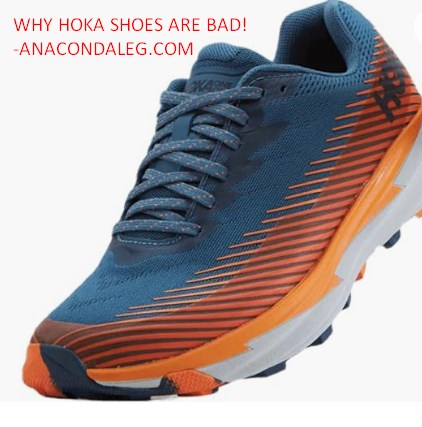Hoka shoes are bad for their excessive cushioning and lack of stability, posing risks for ankle injuries and instability. Still Hoka shoes have gained popularity in recent years for their maximal cushioning and comfort with 20 plus model that we have tested for this research in 3 months.
However, HOKAs may not be suitable for everyone. The excessive cushioning can lead to a lack of stability, increasing the risk of ankle injuries and instability during physical activities. While the extra cushioning may provide comfort for some individuals, it can potentially alter natural foot biomechanics and promote poor running form. And the number is less than 10% as we have seen in our other tests related with HOKAs.
It’s essential to consider individual needs, foot type, and activity level when choosing footwear. Always consult with a footwear professional to ensure the best fit and support for your specific requirements to avoid potential issues associated with Hoka shoes. For our research, we have checked with Dr. Matt and famous Podiatrist center in Miami, Baptist Health Orthopedics.
Understanding Hype: Why HOKA shoes are bad!
In the last decade or so, Hoka Shoes have gained immense popularity in the market owing to various factors. One of the main reasons for their rise is the unparalleled comfort they offer to wearers. The brand has successfully incorporated innovative cushioning technologies that provide exceptional support while maintaining a lightweight feel. However, there is a common misconception surrounding the level of cushioning and support provided by Hoka Shoes. It is important to understand that while these shoes are designed to maximize comfort, they may not be suitable for everyone.

When considering the comfort factor of Hoka Shoes, it is crucial to note that each individual may have different preferences and needs. Some may find the extra cushioning beneficial for reducing joint impact and enhancing their running experience, while others may feel it hinders their performance. It is essential to try on the shoes and determine whether they align with your specific requirements and comfort levels.
Furthermore, it is important to debunk the misconception that excessive cushioning automatically translates to better support. While the cushioning in Hoka Shoes can help absorb shock, it is crucial to consider other factors such as stability, flexibility, and fit when evaluating the overall support provided by the shoes. It’s not just about cushioning; a well-fitted shoe that provides adequate stability can enhance your overall running mechanics.
(You may also check, Are Hoka shoes good for shin splints?)
Possible Threats Of Hoka Shoes
Do you wear Hoka shoes? Well, then you might want to reconsider. These popular running shoes have been gaining attention, but have you considered the hidden dangers they pose to your feet? Let’s take a closer look at the impact Hoka shoes can have on your natural gait and biomechanics.
Risk of overpronation: Best Hoka shoes are known for their plush cushioning, which can cause overpronation. This is when your foot rolls inward excessively after landing, leading to potential injuries in the long run.
Over reliance on cushioning and lack of stability: While cushioning is important, too much of it can lead to a lack of stability. Hoka shoes provide extra cushioning, but this can compromise your natural stability and increase the risk of ankle twists or other injuries.
In summary, it’s crucial to consider the impact of Hoka shoes on your natural gait and biomechanics. The risk of overpronation and overreliance on cushioning without sufficient stability are significant factors to ponder before opting for these shoes.
Unveiling The Potential Health Hazards
When it comes to the impact of Hoka shoes on foot and ankle stability, it is important to consider the potential risks. Excess strain on joints and ligaments is a common issue associated with these shoes. The thick, cushioned soles may provide comfort initially, but they can also cause instability and an altered gait pattern, leading to potential injuries. This includes the development of foot-related conditions such as plantar fasciitis, Achilles tendinitis, and ankle sprains.
(You may check, Can Shoes Cause Shin Splints?)
Furthermore, the excessive cushioning can alter the natural alignment of the feet, contributing to poor biomechanics and musculoskeletal imbalances. The elevated heel-to-toe drop of Hoka shoes can also place additional stress on the Achilles tendon and calves, potentially leading to overuse injuries. You can also check, Are hoka shoes good for shin splints?
It is important to prioritize foot health and choose footwear that provides proper support, stability, and alignment. Consulting with a healthcare professional or a podiatrist can help determine the most suitable shoe options for individual needs and prevent potential health hazards.
Critiques Against Hoka Shoes
Critiques against Hoka Shoes:
Negative customer reviews and experiences have raised concerns about Hoka Shoes. Some runners have reported discomfort and dissatisfaction with the fit and feel of these shoes. Additionally, there have been complaints about the lack of versatility and performance in Hoka Shoes.
Comparisons to other running shoe brands have also been unfavorable to Hoka Shoes. Many runners believe that other brands offer better cushioning, support, and overall performance, making Hoka Shoes fall short in comparison.
Making An Informed Decision
Recognizing individual needs and preferences is essential when it comes to making an informed decision about running shoes. It is always advisable to consult with podiatrists and sports experts who can offer personalized advice based on your specific requirements. They can assess your walking or running patterns, analyze your foot structure, and recommend suitable shoe options. While Hoka shoes have their benefits, it is important to explore alternative running shoe like ASICS GlideRide, Nike Pegasus Trail, Nike React Infinity Run Flyknit as well. This can help you find a shoe that provides the right amount of support, cushioning, and stability for your feet.

Remember, every individual is different, and what works for one person may not work for another. By considering your unique needs, consulting professionals, and exploring alternative options, you can make a well-informed decision when it comes to choosing the right running shoe.
Are Hoka Shoes Bad: FAQ

Are Hoka Shoes Bad For Your Feet?
Hoka shoes are not inherently bad for your feet. However, they may not be suitable for everyone. It is important to find the right fit and support for your specific foot needs. You may like to check, Why Do Hokas Hurt My Feet!
Can Wearing Hoka Shoes Cause Knee Pain?
Wearing Hoka shoes alone does not directly cause knee pain. However, if the shoes are not properly fitted or do not provide the necessary support, it can contribute to knee discomfort. It is essential to choose shoes that align with your individual needs.
Do Hoka Shoes Increase The Risk Of Ankle Sprains?
Hoka shoes do not inherently increase the risk of ankle sprains. However, wearing shoes that do not fit properly or lack proper stability can potentially contribute to ankle injuries. It is important to find shoes that offer the right balance of support and comfort.
Will Hoka Shoes Negatively Impact My Running Performance?
Hoka shoes are specifically designed to enhance running performance for many individuals. However, just like any shoe, the fit and style of the Hoka shoe may not be suitable for everyone. It is crucial to try them on and see how they feel during running to determine the impact on your personal performance.
Summary: Why Hokas Are Bad?
To sum up, while Hoka shoes may have their appeal amongst some runners and athletes, it is essential to consider their potential drawbacks. The excessively cushioned design can lead to a compromised natural gait and increased risk of injury. Moreover, the high price tag may not always justify the advertised benefits.
Ultimately, it’s crucial for individuals to thoroughly research and try on various shoe options to find the best fit for their unique needs and preferences.

